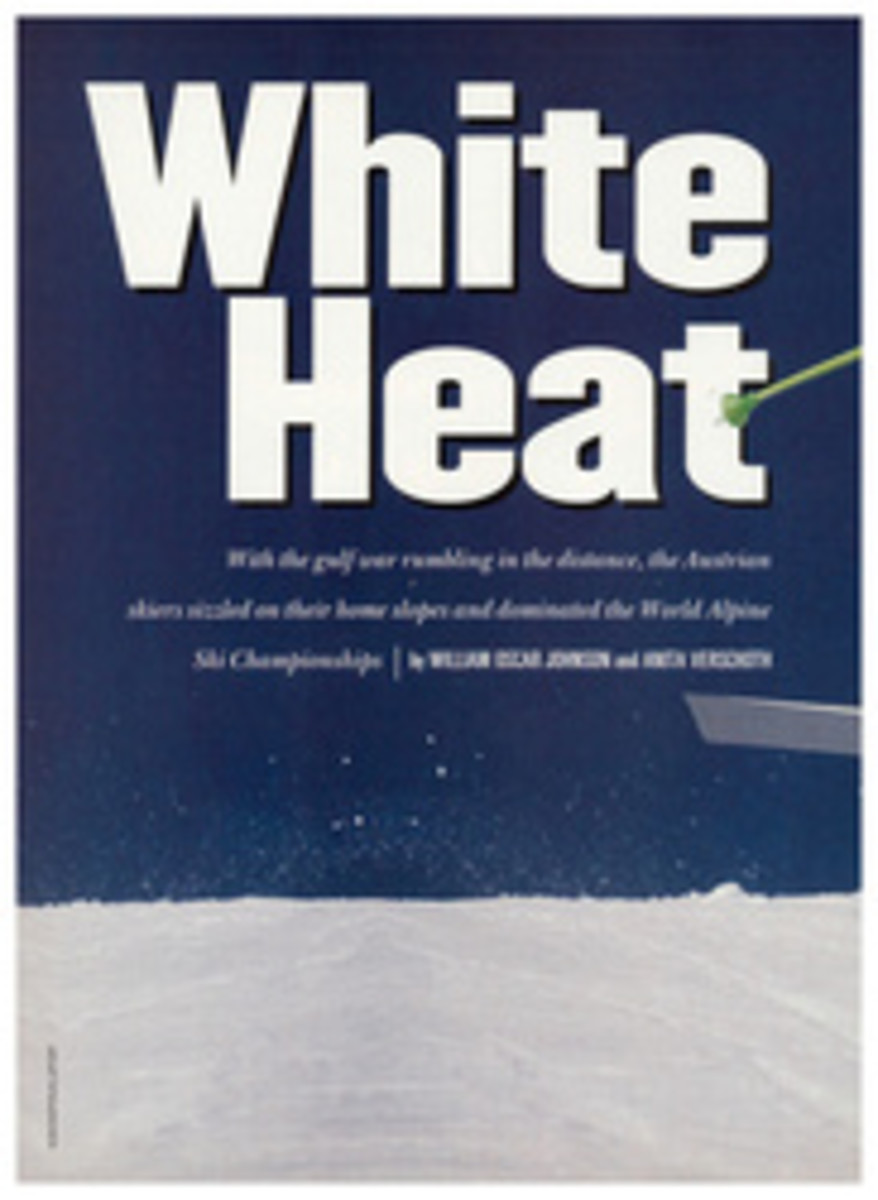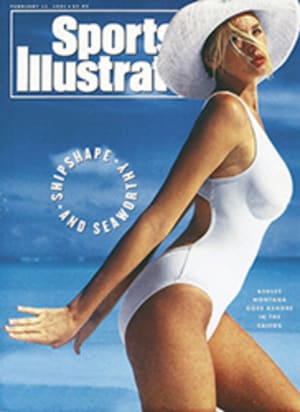
When the Weather Is Frightful, Go Fish
On Thursday morning, when I ventured out to the shed for my waders, I found snow on the ground. By noon it lay heavily in the branches of the fir trees and coated the nearby strawberry fields and distant Christmas-tree farms.
By 2 p.m., checkout lines at the Thriftway in Winslow, Wash., were deep with agitated citizens. On the highway a few cars had nosed into ditches; some drivers had simply pulled over, shut things down and walked away. In the last light of day people hauled firewood up onto porches and threw tarps across their cars. Like me, many of them probably tuned in the 11 o'clock news on this particular night in late February a couple of years ago. Sure enough, schools all around Winslow were shut down, the roads were ghostly and skinned over with ice, the mountain passes were closed. The wise thing, obviously, was to go to bed and confront this frozen world later—to sleep with the heat turned up and the faucets dripping and more white falling beyond the windows.
At 11:30 p.m. I ate three cheese sandwiches, an orange and a bowl of oatmeal. At midnight I put a rubber patch on my waders, and at 1 a.m. I left to go fishing.
"You're crazy," my wife, Robin, asserted in the doorway. "Do you hear me? You're nuts."
I answered that in this she was also right, but that I was going fishing for steelhead trout anyway.
I will admit, too, that it is worse than insane, this so-called sport of winter steelheading. The blunt facts about it attest to that:
1) Half of my fellow Washingtonians who purchase the state steelhead permits will never catch a steelhead in the winter. In fact, a lot of them will never even go steelhead fishing. They'll buy their fishing license and a steelhead permit, and that'll be the whole of it for them.
2) Among those fishermen who do go winter steelheading, many will never see a fish or feel a bite. The brutal truth is that more than half of these steelhead anglers catch only one or two fish a season.
3) Those who do catch steelhead will put in, on average, 15 casting hours per fish. And it is not unusual for a very good angler to go two or three seasons without catching one at all. (Chew on that, bass fishermen, when you take only two or three largemouth in a day and feel like complaining about it.)
4) Oh, yes. To catch winter steelhead, one must sally forth in winter. This is a basic axiom of the "sport." Bad weather. Numb hands. Cold.
Bob Pigott and I spoke of blunt fact No. 4 on that snowy night as we plowed west toward the Hoh River, where the steelhead run, allegedly, sometime between November and March. The Hoh, which coils down from the Olympic Mountains to empty into the Pacific, is a fair producer of steelhead. Not as good as certain streams elsewhere in the state—the Kalama, Cowlitz, Humptulips—but they were in areas so inundated with snow that we couldn't even think about them. Pigott has been fishing for 28 years, having started when he was 16. There is a sticker on his red truck that reads THE WORST DAY OF FISHING IS BETTER THAN THE BEST DAY OF WORK. Soon after our trip this was no longer the case for Pigott. He would wind down his corporate life and move to the coast to become a full-time hunting and fishing guide. Since then, work and fishing and the best days and the worst days have all become one.
"Steelheaders are masochists," Pigott explained to me, his big hands at 10 and 2 on the van's steering wheel. "They want it to be difficult. They want bad weather. They get a sense of satisfaction from suffering. The truth is, you don't really go to catch fish. You go to go. You go to be there, sort of."
Great, I thought. Steelhead Zen koans. The sound of one hand clapping. If a tree falls in the forest and there's no logger handy, will everyone have enough plywood? If a monk stands in a river for 15 winters, will a steelhead eventually brush against his saffron robes?
"It's the fish, too," Pigott said. "They fight like hell."
There's more to it than that, though, and Pigott knows it. The steelhead trout is an anadromous fish, which is an ugly word for a beautiful thing: The steelhead runs through the salt chuck and up into the rivers to spawn in the place where it was born. It is a rainbow trout with a thirst for the sea. Anglers of a poetic and anthropomorphizing bent have raised the steel-head to the level of a myth and have communed, while frozen from head to foot, with the souls of these migrating symbols. A man, after all, would like to live like this, wouldn't he? Be born, travel swiftly, live a life of daring on the high seas, gather all his lust up into one ardent pilgrimage and die in the consummation of it. Or, if not dead, repeat the trick two or three times? No long, slow demise. No worthless afternoons. No 50-year rot-after-ripening.
Pigott allowed that, yes, this was one weird part of it. Then he wisely reined in all the metaphysics and gave his attention to the ice-slicked roads.
It was dawn when we arrived at our put-in at Hoh Forks beneath the last of a crescent moon. Snow highlighted draglines on the clear-cut hills; the road sparkled in the first light. A pink tint backlighted the clouds as we prepared to launch, and soon the frosted stand of birches on the far side of the river stood cleanly illuminated by the morning sun. Pigott took a reading of the air temperature. "Seventeen degrees," he said. "Let's go."
Downstream the gravel bars lay dusted with snow, and icicles hung from toppled maple trees. As we drifted around a bend, a pair of mergansers jumped up and winged off to the west. I began to cast up against the cutbanks and into pocket water, lefthanded wrist flings, dozens of them. Pigott, at the oars, worked me into a hundred nice spots, and I got good long drifts along the bottom.
By noon I had made more than 200 casts—to no avail. We beached the boat just above the old Fletcher Ranch and ate lunch sitting on the cobbles.
"In five hours it'll be dark," I said. "And we haven't even seen a fish yet."
"Two true statements," Pigott said. He was chewing on a piece of blackberry pie and leaning back against a drift log.
"Am I doing something wrong?"
"Not especially. Not really."
"Doesn't it seem cold to you out here today? Aren't you a little cold?"
"It's winter," Pigott said as he swallowed the last piece of pie.
We shoved off one more time. For those of you in the fishing-facts department, I was drifting a Corky and a bit of pink yarn and a two-ought hook, well sharpened. I had pinched a few inches of hollow-core lead on a dropper line just below my barrel swivel, and this bumped steadily along the river bottom, with the hook trailing behind. Occasionally, I would reel in and drape some well-congealed steelhead eggs over my hook after resharpening it painstakingly. (Preservationists arc allowed to denigrate me here for stooping to the crass and greedy practice of bait fishing. But the ethical problem was subsumed by the larger fact that I had never hooked a steelhead. Preservationists should applaud all purists first, lousy fishermen second.)
Your average worm-dangler, by the way, has no idea how difficult it is to catch a steelhead in the first place. The primary fact to consider is that a steelhead traveling upstream to spawn is not in the business of feeding. He'll mouth gently a hundredth of what catches his attention, and then release it. This lip action is subtle and far less noticeable than the bumping of one's lead along the river bottom. It is a kind of stop, a mere break in the rhythm, a subtle nothingness, a dead spot, and the angler has less than a second to perceive it and set the hook accordingly. Thus, for a steelheader, concentration is all—there may well be a thousand fish in the river, 500 of whom have mouthed his offering and none he has been aware of.
The problem is exacerbated by the fact that if the water is too low, if the water is too high, if it is falling, if it is rising, if it is too clear, too muddy, too warm, too cold, too slow, too fast...well then, you can't catch a fish even if you do everything exactly right. I figure there is maybe one day every thousand years precisely right for steelheading. It rarely comes on a weekend, either.
Pigott and I, drifting down the Hoh, discussed these matters as we pinched on lead or knotted up new leaders. Pigott said that, if nothing else, I had developed a good sense of the sport's basics: painful weather, no fish, persistently bad water conditions and no perceptible bites. He figured that was the long and short of it—the truth, as he knew it, about winter steelhead fishing, with occasional exceptions of from five to 20 pounds thrown in at distant, eccentric intervals.
I fished on into shadows, into a frozen dusk, and finally a February darkness descended. There was a snagged line that gave me a hopeful lurch—nothing more—and then Pigott and I beached the boat. My first season of steelheading was behind me.
Now, I would have liked to deliver to my readers some more river notes, some peaking action followed by an explosive fishing climax—a big steelhead well-hooked, a cathartic series of leaps and dashes, a beaching, a revelation, a fitting finale, a moral to the story ("It was all worth it after all"). It is what you no doubt expected at the outset of this, having read any number of fishing fables. But perhaps the expectation of an actual fish lies as close to a truth as we shall ever get here. In a story about steelhead, as in steel-heading itself, let there be no expectations. Let there be the winter, first of all, that season most of us miss. And let there be emptiness and unfulfilled desire and the profound complexity of fish in rivers. And always, let there be next year.
David Guterson is a frequent contributor to this magazine.
TWO ILLUSTRATIONS
PAUL COX

